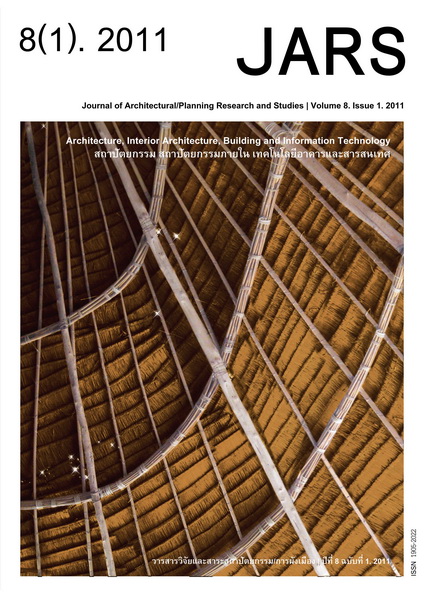Re-utilizing Space: Accommodating Tourists in Homestay Houses in Northern Thailand
Main Article Content
Abstract
This paper discusses the way in which rural houses in Northern Thailand are adapted to meet
emerging demand for tourist accommodation in a private ‘homestay’. It is based on qualitative fieldwork in
three homestay villages in Northern Thailand. The research combines the studies of vernacular tradition,
tourism and ‘home’ in order to explain the changes in homestays by analyzing the interrelationships between
space use, social interaction and the meaning of home and homestay. The findings reveal that the norms
concerning guest space, patterns of life and the perceived meaning of home in the Northern Thai context play
significant roles in adjusting the lives and outlooks of residents, as well as their space, to homestays. While this
has positive implications in terms of re-using space to supplement the family income, homestays also bring
about profound shifts in the moral values and meanings of home. The research differs from other home and
homestay studies as it bridges the three fields of architecture, tourism and the study of home. It thereby
contributes to our understanding of transformation and continuity within a vernacular environment and tradition
undergoing significant internal and external forces of change.
Downloads
Article Details

This work is licensed under a Creative Commons Attribution-NonCommercial-NoDerivatives 4.0 International License.
All material is licensed under the terms of the Creative Commons Attribution 4.0 International (CC-BY-NC-ND 4.0) License, unless otherwise stated. As such, authors are free to share, copy, and redistribute the material in any medium or format. The authors must give appropriate credit, provide a link to the license, and indicate if changes were made. The authors may do so in any reasonable manner, but not in any way that suggests the licensor endorses you or your use. The authors may not use the material for commercial purposes. If the authors remix, transform, or build upon the material, they may not distribute the modified material, unless permission is obtained from JARS. Final, accepted versions of the paper may be posted on third party repositories, provided appropriate acknowledgement to the original source is clearly noted.
References
Alsayyad, N. (1995). From vernacularism to globalism: The temporal reality of traditional settlements. Traditional Dwellings and Settlements Review, 7(1), 13-24.
Borchgrevink, C. P. (1999). The historical perspective. In C. P. Borchgrevink (Ed.), Perspectives on the hospitality industry: An introduction to hospitality management (pp. 39-49). Iowa: Kendall/Hunt.
Bouquet, M., & Winter, M. (1987). Who from their labours rest?: Conflict and practice in rural tourism. Avebury, Aldershot.
Cohen, E. (1988). Authenticity and commoditization in tourism. New York: Pergamon.
Douglas, M. (1991). The idea of a home: A kind of space. Social Research, 59(1), 287-307.
Dovey, K. (1985). Home and homelessness. In I. Altman & C. M. Werner (Eds.), Home environments, human behavior and environment: Advances in theory and research (pp. 33-64). London: Plenum Press.
Finch, F. F. (2001). Homestay: Social and cultural consequences, a case study in Yao Noi Island Thailand. Masters dissertation, Department of Planning, Oxford Brookes University, Oxford.
Herzfeld, M. (1987). As in your own house: Hospitality, ethnography, and the stereotype of Mediterranean society, In D. D. Gilmore (Ed.), Honour and shame and the unity of the Mediterranean (pp. 75-79). American Anthropological Association, Washington, D.C.
Hochschild, R. (2001). The time bind: When work becomes home and home becomes work. New York: Henry Holt.
Kent, S. (1990). Activity areas and architecture: An interdisciplinary view of the relationship between use of space and domestic built environment. In S. Kent (Ed.), New directions in archaeology, domestic architecture and the use of space: An interdisciplinary cross-cultural study (pp. 1-8). Cambridge: Cambridge University Press.
Lawrence, R. J. (1982). A psychological-spatial approach for architectural design and research. Journal of Environmental Psychology, 2(1), 37-51.
Lynch, P. (2003). Conceptual relationships between hospitality and space in the homestay sector. PhD dissertation, Queen Margaret University College, Edinburgh.
Maher, V. (1984). Work, consumption and authority within the household: A Moroccan case. In K. Young, C. Wolkowitz & R. McCullagh (Eds.), Of marriage and the market: Women’s subordination internationally and its lessons (pp. 117-135). London: Routledge & Kegan Paul.
Marcus, C. C. (1995). House as a mirror of self: Exploring the deeper meaning of home. Berkeley, California: Conari Press.
Oliver, P. (2003). Dwellings: The vernacular house worldwide. London: Phaidon.
Oranratmanee, R. (2008). Rural homestay: Interrelationships between space, social interaction and meaning in Northern Thailand. PhD dissertation, Oxford Brookes University, Oxford. Short, J. R. (1999). Forward. In I. Cieraad (Ed.), At home: An anthropology of domestic space (pp ix-x.). Syracuse: Syracuse University Press.
Smith, V. (1977). Hosts and guests: The anthropology of tourism. Philadelphia: University of Pennsylvania Press.
Stringer, P. F. (1981). Hosts and guests: The bed-and-breakfast phenomenon. Annals of Tourism Research, 8(3), 357-376.
Tilley, C. T., & Keane, W., et al., (Eds.). (2006). Handbook of Material Culture. London: Sage.
Tuan, Y. F. (1989). Traditional, what does it mean?. In J. P. Bourdier & N. Alsayyad (Eds.), Dwelling, settlement and tradition: Cross-cultural perspectives. Berkeley: University Press of America.
Vellacott, A., & Christmas, L. (1982). Doing bed and breakfast. Vermont: David & Charles.
Vellinga, M. (2006). Engaging the future: Vernacular architecture in the 21st century. In L. Asquith & M. Vellinga (Eds.), Vernacular architecture in the 21st century: Theory, education and practice. London: TAF.
Wall, G., & Long, V. (1996). Balinese homestays and indigenous response to tourism opportunities. In T. Hinch & R. W. Butler (Eds.), Tourism and indigenous peoples (pp. 27-48). London: Thomson.


